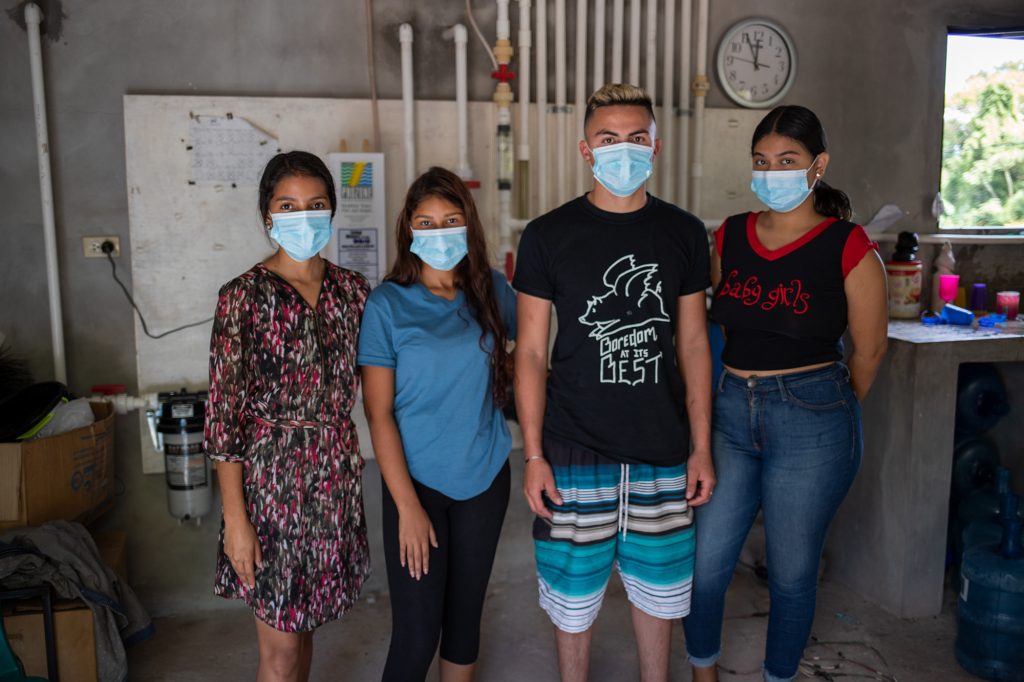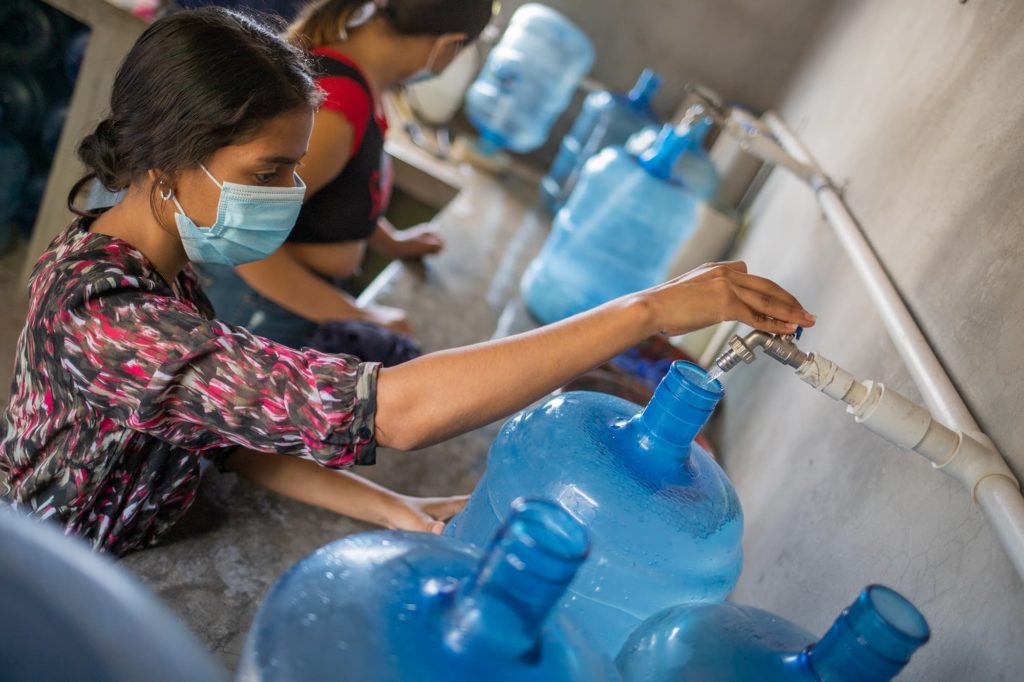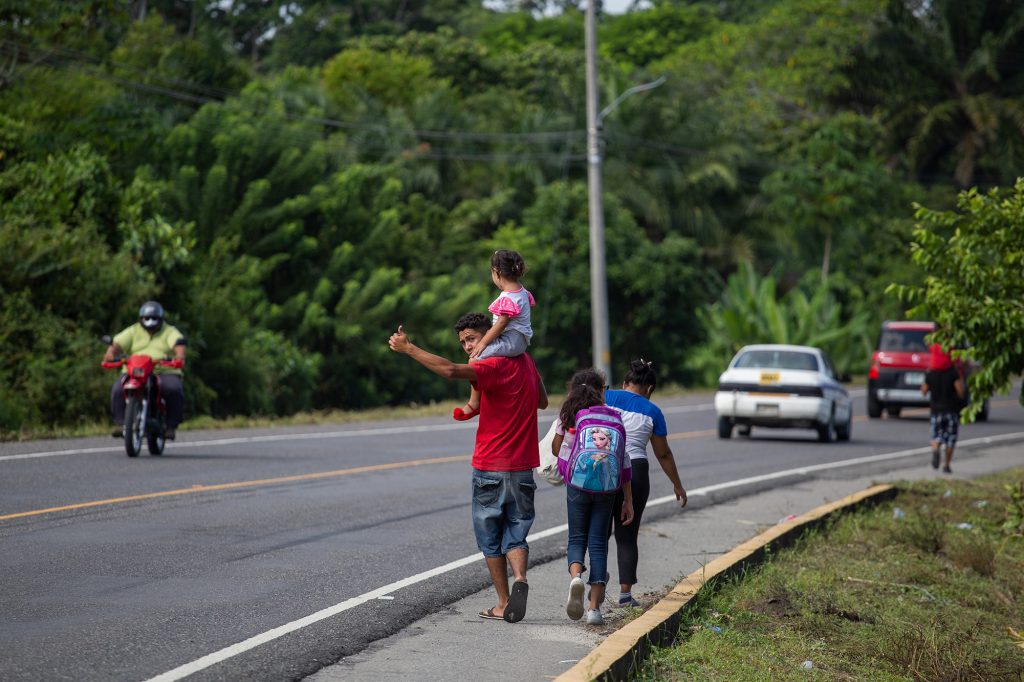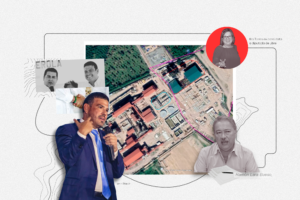The Youths Building the Future program was launched two and half years ago, and now nearly 4,000 Honduran youths are working at 130 companies in jobs funded by a Mexican government program. They are paid a stipend that is half the minimum wage in Honduras. Despite its slow implementation, Mexican President Andres Lopez Obrador is urging the United States to adopt and fund this model as an incentive for Central American young people to stay home instead of migrating north.
By Alberto Pradilla and Allan Bu
Photos by Martín Cálix and Antonio Gutiérrez
Nineteen-year-old Jennifer Salgado was hoping to receive her first paycheck as a grantee in the Youths Building the Future (Jóvenes Construyendo el Futuro) program in San Pedro Sula, Honduras’ second-largest city. She had been working for a month at Diunsa, a national chain of retail stores, and was waiting for a bank notification to claim US$180 in wages from the Mexican government. But after a whole month’s work, she hadn’t been paid ─ her bank account was still at zero. Salgado started in May, and weeks went by as she worked without pay while waiting for a sum that was below the US$538 monthly minimum wage for that industry.
Salgado lives with her mother in Cofradía, a municipality that is more than 30 kilometers from her job in San Pedro Sula. It takes her over an hour on public transport to get to work. When she could no longer afford the bus fare, her co-workers chipped in so she wouldn’t miss work.
“I only just got paid,” said Salgado. She received her first month’s pay in September, four months after she started working. Her supervisor had told her to stop coming to work, that she’d hold the position open until the money arrived from Mexico. Fortunately, another position opened up, so she left the program and became a company employee. Salgado now earns almost US$540 per month, triple what she received from the Mexican government, and enough for her to pursue her university studies in accounting and finance.
“I thought about migrating to the United States, but I was too scared,” said Salgado. Four of the 12 program interns that Diunsa hosted are now permanent employees. Two others are waiting for positions to open up, and another two have to decide whether to start the program knowing that they won’t get paid for at least two months, and will earn an insufficient stipend that may not dissuade them from migrating.
Slowing down migration to the United States is the stated objective of the Youth Building the Future and Sowing Seeds of Opportunity programs that have been expanded from Mexico into Honduras, El Salvador, and Guatemala. But youths in these countries say that US$180 a month won’t dissuade them from migrating.
In July 2019, Mexico’s foreign minister, Marcelo Ebrard, announced that 20,000 scholarships would be funded in each Northern Triangle country; an investment of US$30 million per country. Just like the Mexico programs, Central American youths would be paid US$180 per month for a nine-month scholarship. They work a maximum of eight hours a day, five days a week for half the Honduran minimum wage. Payment is made by the Mexican Agency for Development Cooperation (Agencia Mexicana de Cooperación para el Desarrollo ─ AMEXCID) through local banks. There is no intermediary ─ no Honduran government agency touches a penny.
The Youths Building the Future program pays US$180 per month during a nine-month scholarship.
Two and a half years after Mexico’s pledge, the two AMEXCID programs are slowly moving forward, hampered by operational problems but also enjoying some limited success.
Animal Político (a Mexican media outlet) and Contracorriente visited several companies in the northern Honduran municipalities of San Pedro Sula and El Progreso, and others in the central Honduran city of Comayagua, areas of focus for the internship programs because of their high rates of emigration.
Our inquiries revealed two major shortcomings; delayed payment of stipends and unfilled internship positions due to a lack of applicants. Despite these issues, the programs do provide Honduran youths with some income in a country with a high unemployment rate.
President Andrés Manuel López Obrador (known by his initials, AMLO) views these programs as models for fostering development in Central America. He recently persuaded President Joe Biden to launch Sowing Seeds of Opportunity (Sembrando Oportunidades), a project that consolidates existing social programs and will be jointly operated by AMEXCID and the U.S. Agency for International Development (USAID). According to the U.S.-Mexico joint statement released on December 1, the initiative aims to reach more than 500,000 at-risk youth in Honduras. However, no timetables or specific funding allocations have been specified. Nor is there any information about the terms of employment or the wages. The current scholarships pay less than half the minimum wage and there is no contractual relationship with the employer other than registration on a website.
The Sowing Seeds of Opportunity initiative was announced around the same time that the U.S. and Mexico jointly declared that the latter nation would again receive migrants seeking asylum in the United States under the Migrant Protection Protocol, a program initiated by the Trump administration that was in effect from 2019-2021. Some analysts believe that AMLO’s focus on linking immigration control and investment in Central America means that both initiatives were part of the same bilateral negotiation.
President-elect Xiomara Castro’s victory on November 28 adds another chair at the negotiating table. During her presidential campaign, the leftist politician promised to work with the Biden administration to support social programs that prevent forced migration, but it’s not known whether she will embrace the initiatives announced by the U.S. and Mexico.
Mexico points fingers at Honduran financial institutions
“Getting paid was a problem. I worked for two months without getting paid. I put up with it just to see what would happen. I was about to quit because I wasn’t making any money when my employer said they would hire me. I worked there for four months before they hired me,” said Eddy Alejandro González Hernández, a 19-year-old employee of Auto Repuestos, an auto parts franchise with stores in Honduras’ main cities.
González heard about the internship program from a relative, the company’s human resources manager. He says he was able to stick it out because of family support, but other colleagues dropped out because they weren’t getting paid. “Many of my friends have left for the United States or Spain. I wanted to go,” said González, “but my grandparents told me not to.”
The Mexican Ministry of Foreign Affairs, which is responsible for the program, lays the blame on Honduran financial institutions. In response to questions about the payment delays, the ministry stated, “When an individual joins the program, that person is responsible for registering with the bank to receive the monthly payments. If this is not done within an established period before funds are disbursed, AMEXCID is unable to direct the funds to the beneficiaries.”

“AMEXCID learned that some of the program participants didn’t have bank accounts and lacked experience with financial services,” stated the Mexican Ministry of Foreign Affairs, adding, “The program now helps new participants set up accounts when they join, and they are also informed about the procedures for getting paid on time.” The ministry noted that employers participating in the program are not required to provide the youths with any financial assistance and that the grantees aren’t paid if they fail to fulfill their responsibilities.
The Mexican government pays the grantees through a Honduran bank. When the monthly wages are ready, a code is sent to the individual’s cell phone, notifying that the funds can be withdrawn at the local bank. But Jennifer Salgado and Eddy González both denied having problems registering with their banks and said that they simply didn’t get paid on time.
AMEXCID reports almost 4,000 participants in Honduras
The delay in program implementation is one of the main problems faced by the Mexican government. President López announced the projects in June 2019 after meeting with Presidents Nayib Bukele (El Salvador) and Juan Orlando Hernández (Honduras). Mexican Foreign Minister Marcelo Ebrard then set March 2020 as the date for the first program evaluation, but it came and went with no progress. Shortly thereafter, the COVID-19 pandemic forced countries to close international borders and AMEXCID had to suspend the program.
AMEXCID data indicates that 3,942 Honduran youths currently participate in the program, while 6,058 are in the initial process of document verification and 783 have already completed their internships. There is no data on how many were ultimately hired by the host companies. AMEXCID says that there have been no program dropouts, but Animal Político reports that only half of the grantees completed the program.
AMEXCID data indicate that 3,942 Honduran youths currently participate in the program, while 6,058 are in the process of document verification and 783 have already completed their work contract.
The overall budget for this initiative in Honduras is US$31 million, of which US$11 million has been allocated to Youth Building the Future and US$20 million to Sowing Seeds of Opportunity. However, only US$9 million (29%) has been spent so far.
An information request submitted to AMEXCID produced a list of 130 Honduran companies participating in the program. But if almost 4,000 Honduran grantees are currently working, the 130 companies would have to be hosting 30 grantees each. However, many of the participating companies are grocery stores, small businesses, and even individual business owners who applied to host between two and five youths. Furthermore, some companies enrolled in the program but have yet to be assigned any. Sergio Portillo, the manager of Las Brasas restaurant in El Progreso (Yoro) says that no youth have been assigned to their business, months after they enrolled in the program.
When questioned about businesses that have not been assigned grantees, the Mexican Ministry of Foreign Relations stated, “The youth are allowed to choose the work location and training plan that best fits their professional and skills development goals. Each participating company, association, or organization receives applications from potential applicants that have expressed interest in their proposed positions. AMEXCID does not intervene in the youths’ choice of the workplace and training plan. It only connects them [youth and businesses] so that they can benefit from the program.”
The list of participating companies obtained through our information request only indicates the company name and general location (municipality and department). Despite our request for more detailed information, AMEXCID did not provide an address or tax identification number, which makes it difficult to determine whether the participating companies exist. The Mexican aid agency says that they do not corroborate company taxpayer information because they lack the authority to do so in a foreign country. AMEXCID can only use the company documentation submitted through the program website to verify the company’s existence. Animal Político and Contracorriente were unable to locate a number of companies, including Inversiones de Desarrollo Arquitectónico y Modernización Sostenible, a firm requesting 56 youth that is supposedly located in San Pedro Sula. The firm is registered with the Cortés Chamber of Commerce but does not list an address.
Limited success in Comayagua
The centrally located Department of Comayagua is a top focus area for the program due to its large number of emigrants. According to Honduras’ National Institute of Statistics (Instituto Nacional de Estadística ─ INE), Comayagua had a 10.9% unemployment rate in 2020 and a 27% underemployment rate, another reason why AMEXCID focused on this region.
Of the nearly 4,000 program interns currently working around the country, 2,157 are in Comayagua. The municipality of El Rosario alone has 1,052 interns. El Rosario has one of the country’s highest emigration rates, and many people from there have been killed in Mexico during migrant massacres, such as the 2012 Cadereyta massacre and the 2021 Guanajuato murders. Other municipalities like San Pedro Sula have much lower numbers of program interns. Most of the migrant caravans since 2018 have departed from San Pedro Sula, yet only 201 grantees are currently working in that municipality.
“The only jobs for young people around here are in construction, coffee harvesting, or as a farmworker. But most of the time there’s no work at all. There are very few options and there’s nothing for young people who have some higher education,” says Ivis Alvarado, the owner of a small convenience store in the community.
The biggest promoter of the Youths Building the Future program in El Rosario is the municipal government, says Nancy Padilla, coordinator of the municipality’s Office of Children and Youth. Padilla says that El Rosario was selected as a program focus area because so many youths leave the community to migrate to the United States.
“There were very few opportunities, but the program has persuaded many young people to stay,” she said, while acknowledging that the exodus persists.
Everyone in the community knows about the program. A typical day’s pay in this municipality is about US$5, but the Mexican program is only viewed as a stopgap measure. About 50 small businesses are hosting grantees under the program, but only because Mexico is paying the stipend. “There’s not much commercial activity in this town. Most businesses bring in just enough to survive, so they aren’t able to provide jobs,” says Alvarado.
The youths can participate in the program for up to nine months. Alejandra Montoya is 26 years old and is grateful to the program for the work experience she is getting. An intern at the community health center, she maintains patient health records and helps in other tasks assigned by the health care team. She is a single mother and has a college degree in Science and Literature. “Our wages were paid promptly,” she said; only the first month’s pay was delayed. “It’s helped me a lot,” Montoya said.
“There are a lot of young people around here and job opportunities are scarce. Many are now working as bricklayer assistants and are doing well thanks to this program,” said Onix Zepeda, a 19-year-old man working as an intern in a small water purification plant. Four other youth have been working there for the past four months. Zepeda says he has no intention of migrating for the time being.
Fleeing north is a way out for thousands of Hondurans. In 2021 alone, almost 98,000 Hondurans were detained in Mexico during migration journeys to the United States, close to half of the 228,000 migrants detained over the last 11 months. Andres Manuel Lopez Obrador has now arrested more foreigners in one year than any other Mexican president.
“I wanted to leave like everyone else. I think that almost every young person in Honduras dreams of going to the United States,” said 18-year-old Selvin Orellana. He thinks that the only problem with the scholarship is that “it’s too short.” He and his friends aren’t thinking about emigrating right now, but he doesn’t know what will happen when the program ends.










